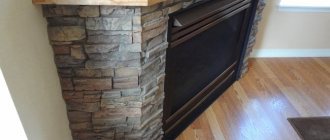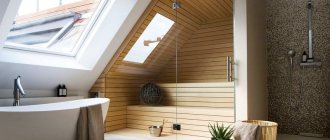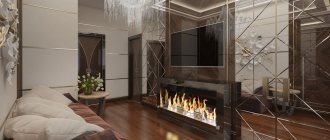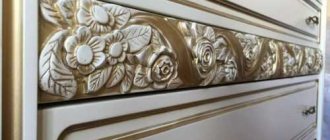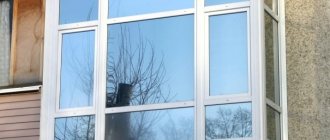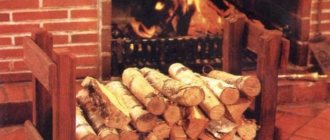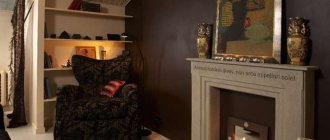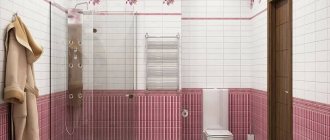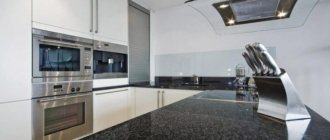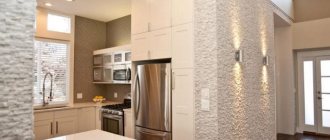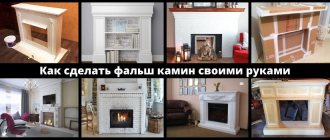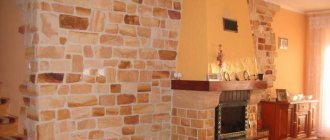A fireplace in the interior of an apartment means comfort, harmony and tranquility. This decorative component will give a feeling of peace, comfort and well-being to any room. Your home will gain dignity, become unique and a favorite place for family gatherings, romantic evenings and meetings with friends.
What should the fireplace lining be like?
Since there are many options for making a fireplace, it is difficult to name the ideal finishing material . It all depends on a lot of factors :
- fireplace type . The material for a wood-burning fireplace should be selected as carefully as possible, taking into account the constantly exposed high temperature. If you decide to go with an imitation fireplace with candles or an electric version, then the finishing requirements will not be so strict;
- fuel type The combustion temperature of different types of fuel is different, which must be taken into account when analyzing the parameters of finishing materials. For example, if you are going to use firewood, then it is important that the lining can withstand temperatures of about 9000C, but if we are talking about coal, then it is better to take a material that can withstand temperatures of about 11000C;
- installation location . If you are going to install a fireplace on the terrace, then it is important that the material has excellent frost resistance. If used in a heated room, such a requirement is not made. If the fireplace is located in a house where people visit only occasionally, then pay attention to such a parameter as moisture resistance;
- material weight . Material that is too heavy (for example, natural stone) may require strengthening the foundation, which is only possible in a private house and when installed on the ground floor. If it comes to an apartment or the upper floors of a private house, then you should definitely take into account what load the floors can withstand;
- appearance . The purpose of cladding is to decorate the fireplace, so when choosing a material you should take into account its appearance and compliance with the chosen interior style and color scheme.
English stone fireplaces
When we talk about England, the first thing that comes to mind is a stone fireplace. It gives an atmosphere of warmth and home comfort. In country houses it is necessary as the main element of the interior of the house. You can sit around it with your loved ones or spend a beautiful romantic evening with a glass of fine wine.
The English style never loses its ambition thanks to rigor, asceticism, ambition and win-win, reliability and elegance. In addition, it gives the room coziness and spontaneity, serenity and peace.
If the room has sufficient dimensions, you can place a woodpile near the fireplace
The fireplace adds a touch of individuality and uniqueness to the overall interior. Black fireplace with a very attractive appearance
A wood-burning fireplace is a good alternative to traditional heating
A fireplace can be part of the interior of a bedroom, living room, dining area or even a children's room in a city or country house. It has a magical quality and willy-nilly attracts the attention of guests at home. Helps to win respect, admiration and special awe of the owner. After all, this is the status, character, interests and values of the owner of the house.
No. 1. Fireplace tiles
Tile is the most popular way to decorate a home. You cannot use ordinary tiles - they will not withstand high temperatures. As a rule, the following types of ceramic tiles are used for facing a fireplace:
- terracotta tiles Made from baked clay, it has a beautiful natural reddish tint. In most of its properties, it resembles the refractory red brick from which fireplaces are made, so as the temperature in the firebox rises and falls, the tiles will expand along with it. Terracotta tiles have a smooth, coarse-grained structure. Additional pigments are not used in production, but the natural range of shades ranges from light brown to almost black;
- Majolica is also made from baked clay, but is covered with painted glaze on top, so it costs more, but also looks very beautiful. When decorating a fireplace with majolica, you need to carefully think through the sketch, because cutting such tiles is not entirely impossible, but very stupid. In addition, installation requires sufficient qualifications from the master, because the slightest flaws will be clearly visible. Due to the high cost and difficulty of working, our fireplaces are very rarely decorated with only majolica - it is usually used fragmentarily, as an accent and decoration. This solution looks great;
- clinker tiles are made from special refractory types of clay, therefore they are able to withstand high temperatures, and also have excellent frost resistance and moisture resistance. The color range is represented by shades of brown and terracotta, but thanks to various surface decoration technologies you can get very interesting options;
- fireclay tiles It accumulates thermal energy well, cools for a long time, and retains heat well. The material will expand with the fireplace body and can withstand extremely high temperatures. Fireclay tiles are thicker than terracotta tiles.
Porcelain stoneware and tiles are sometimes included in this group , but the uniqueness of their characteristics forces us to consider each of these materials separately.
Tiling a fireplace has many advantages :
- resistance to high temperatures, the ability to “breathe” with the fireplace;
- high heat transfer and the ability to accumulate heat, which increases heat transfer;
- moisture resistance, frost resistance, resistance to sunlight;
- ease of care;
- durability;
- environmental friendliness, no odors when heating;
- chic appearance and ample choice.
It’s hard to name any downsides, except that the price of some products can be intimidating. To install tiles, you do not use ordinary tile adhesive - you need a heat-resistant compound. You can make a special clay composition yourself, but you will need to find suitable clay and experiment with proportions, so it’s easier to settle on a ready-made version.
It is better to buy tiles with a margin of 10-15%, and you can purchase not only standard format products, but also corner elements. Installation does not require special skills or the use of specific tools:
- preparatory work consists of removing the old lining from the fireplace. After this, it is also advisable to embroider the masonry seams 1 cm deep. Dust is carefully removed, the brick is moistened with water. Using heat-resistant mastic or clay mortar, minor unevenness is eliminated. If there are significant deformations, it is better to use a grinding wheel. If the brick begins to crumble, it does not hurt to install a reinforcing metal mesh with a mesh size of 1.5 cm;
- Before starting work, it is necessary to heat the fireplace for several hours so that the brick warms up sufficiently. The tile itself must remain in the room where the work will take place for 48 hours;
- the surface of the fireplace is primed, reducing dust levels and improving adhesion. The primer should be allowed to dry for about 2 hours;
- The tiles can first be laid out on the floor to understand which elements will have to be trimmed;
- The glue is prepared according to the instructions indicated on the package. It is better to mix with a construction mixer, but a drill with an appropriate attachment will do;
- The laying begins with special corner elements, if they are used. Then the lower rows are installed;
- The adhesive solution is applied with a flat spatula, and 3-4 elements are installed at once. To ensure that the distances between the tiles are the same, special crosses are used;
- After installing the tiles, the seams are grouted. To do this, use special store-bought solutions or a homemade clay mixture with sand and dyes;
- when everything is dry, it is advisable to cover the surface of the unglazed tile with a layer of heat-resistant varnish. This will simplify subsequent care.
Analyzing the numerous advantages of the material and the ease of its installation, it is easy to guess why it has gained such high popularity.
Art Nouveau hearth
Once upon a time, the word modern meant everything new and progressive. Nowadays, modern style is manifested in contrasting colors using calm natural shades, the use of non-trivial decor, mirror and glass surfaces, and various textures within the same room.
An impressively sized fireplace, lined with asbestos-cement sheets and decorated with a stone platform, became the focal point in this spacious Art Nouveau living room.
The space near the fireplace can simply be covered with plasterboard and painted with fire-resistant paint, and near the fireplace it can be lined with stainless steel; a mantelpiece made of the same material will serve as a decoration.
Original in design, neutral in terms of color schemes, but at the same time eye-catching, this fireplace literally revolutionized the appearance of the Art Nouveau living room.
A fireplace built into the corner of the room will save a lot of space, and facing it with mosaic tiles will allow you to implement any color schemes, apply a geometric pattern or even an artistic image.
A non-trivial approach to arranging the hearth is reflected in the fireplace built into a plasterboard niche in the form of a porthole. Strict, but at the same time contrasting design adds variety to the snow-white decoration of the room, giving it a personalized, original appearance.
The relief pattern on the surface of the fireplace not only brought sculptural variety to the decor of the living room-library, but also gave it a touch of closeness to nature. Such a design can be a successful decoration for both country and urban premises.
No. 2. Natural and artificial stone for facing the fireplace
The stone in the decoration of the fireplace looks as organic as possible and may even resemble the Middle Ages, but the perception of the portal will largely depend on what type of stone is chosen (or what type of artificial stone imitates).
As for natural stone the following rocks are used for cladding the fireplace :
- granite is a hard rock, has a wide range of shades, does not collect scratches, and is easy to care for. The surface can be either wild (with “ragged” edges) or smooth polished;
- Marble is the most popular stone for finishing a fireplace. It has a huge range of shades, is relatively inexpensive, and looks great;
- Shell rock captivates with its low price and easy processing. Looks great, but isn't very durable. It has a soft porous structure, so soot particles will gradually accumulate in the pores, spoiling the appearance. If you light the fireplace infrequently, then shell rock will do;
- limestone and sandstone have a sufficient number of shades, but cannot boast of strength, and soot may remain in the pores of the material;
- slate - durable and beautiful material, but its peculiar appearance does not allow us to call the breed universal.
Natural stone is heavy and quite expensive, so today its artificial counterpart is actively used. Natural stone for fireplaces is sold in the form of slabs . Often this format is called stone tiles or flagstone . Since the shape of such tiles is usually different, it is better to first lay out all the elements on the floor so that you can select and process all the elements in time. When installing natural stone, you cannot do without a mesh, otherwise the finish risks collapsing.
Artificial stone is made from Portland cement with the addition of expanded clay or from gypsum. The mass is poured into molds, which are obtained by making casts from natural stones. Such products are cheaper, weigh less, can have any color and shape, and in terms of strength and other performance qualities they are practically not inferior to natural stone, and some types are even superior.
The main advantages of facing a fireplace with stone:
- resistance to high temperatures;
- environmental friendliness and safety;
- chic appearance;
- durability;
- for artificial stone, ease of installation and processing, low weight, price;
- for natural stone – the uniqueness of each element.
The technology for laying stone is similar to the installation of tiles described above. It is not necessary to leave gaps of the same size between the stones (as is the case with tiles), so everything will be even simpler. For installation, use a special heat-resistant adhesive for stone. It is recommended to additionally secure the heaviest stones with anchors. Otherwise, everything is the same as with tiles. First, the surface is prepared, primed, glue is diluted, then the installation of stone begins from the bottom row. Before starting work, it is recommended to heat the fireplace and lay the stone on the floor to assemble the future “drawing”. In the case of natural stone, the elements may have a slightly different shade. This must be taken into account in advance. It looks best when the bottom rows are slightly darker than the top rows. If desired, the stone is coated with heat-resistant varnish.
Minimalism in the design of the hearth
Considering the tendency of modern style towards minimalism, such a strict design of a fireplace without decor will harmoniously fit into the interior of the living room, bedroom or dining room.
In this living room, the fireplace is completely hidden behind a false panel without highlighting the chimney space. Strict cladding with ceramic or stone tiles, in rare cases, porcelain tiles, concrete or metal coating are the most commonly used types of finishing.
Despite the fact that the living room of a country house is not made in a minimalist style, the design of the fireplace was done in the simplest possible way - using painted concrete plaster. The deep natural color of the fireplace matches the spectrum of colors of the entire interior, but at the same time acts as a dark contrasting spot.
The snow-white decoration of the living room was repeated when decorating the space around the fireplace. The minimalist design model allowed only small inclusions of grayish shades.
The stark, dark fireplace surround provided a contrasting focal point in the living room, which features a neutral color palette. Nothing in the design of the fireplace distracts from the overall calm atmosphere of the room.
Strict and laconic cladding of the fireplace using stone tiles in neutral shades is an ideal option for a contrasting interior in black, white and gray tones.
As a rule, the fireplace space has a protrusion in relation to the wall, but in this minimalist living room the hearth is located in a niche, which can be closed with a sliding niche if desired. The ledge in front of the fireplace can be used as seating or an open shelf, and the small alcove can be used as a woodpile.
A huge fireplace, covered with steel sheets painted black, can “withstand”, perhaps, only a really spacious room with a neutral finish, large windows, plenty of natural light and furnishings in a minimalist style.
Another example of a similar fireplace, but smaller in size and in light colors.
An interesting option for the location of the fireplace for a minimalist living room could be a corner design of the hearth, the strict decoration of which does not distract from the main thing - observing the fiery flame.
Originality of execution, clarity and smoothness of lines, neutral natural palette - everything in this fireplace is measured and balanced.
There is nothing superfluous in the decoration of this fireplace, located almost at the entrance to the building - a modest cladding with glossy subway tiles and a small podium for fireplace accessories. In the spirit of a living room with minimalist furnishings, the fireplace space is austere and modest.
No. 3. Brick fireplace decoration
This is not even finishing in the traditional sense of the word. In this case, there is no question of installing some kind of facing material on top of the fireplace. The brick from which the fireplace is constructed is finished accordingly. This is both the simplicity and complexity of the method.
If you initially planned not to use any additional facing materials, then when laying the fireplace, the mortar must be laid so that 5-7 mm remains to the outer edge of the brick. Later this void will be filled with decorative grout. If the fireplace has already been built, then you can grout the joints in order to subsequently use grout of a certain color. The brick can be left untouched, but can be sanded or chamfered. Such work should be performed by an experienced specialist. Not every stove maker is ready to take on this, so it’s better not to do this type of cladding yourself . Brick can be treated with hydrochloric acid solution - this will give the material a more saturated color.
There is a more standard way. This is finishing with ceramic facing bricks . The material can withstand high temperatures, looks great and expands the possibilities of decoration. The masonry is not much different from the laying of ordinary bricks. True, you will have to ensure that the seams are even (as is the case with tiles), and then seal them with heat-resistant mastic.
Less popular methods
It’s worth talking right away about decorating the fireplace with tiles. The method is quite old, but today it is very rarely used. Firstly, such finishing is possible only when constructing a fireplace. You cannot cover an already finished hearth with real tiles.
Secondly, the installation is so complicated that it requires a highly specialized specialist. Tiles are already a very expensive pleasure. And the involvement of a master in the work makes such a fireplace truly “golden”.
You can line the fireplace with brick. In this case, there are two ways. They take plastic molded ceramic bricks and lay out the external walls. In the second case, the main masonry is refined. The seams are deepened and cleared. Then they are filled with special compounds.
The brick itself is also subjected to various treatments. Hydrochloric acid solution for color saturation. And before that, each element is polished or chamfered. The complexity of such finishing is so great that not every stove maker will take on the job.
No. 4. Cladding the fireplace with porcelain stoneware
Porcelain tile is not a natural material, but it contains natural components. A special technology makes it possible to create a material that is not inferior in strength to natural stone. The composition includes clay, mica, sand, metal oxides, feldspar and granite or marble chips. Porcelain tiles can replicate the pattern of any natural stone and are distinguished by a minimal number of pores , which explains its performance qualities.
Advantages of the material:
- wear resistance and high strength;
- ability to withstand high temperatures, so porcelain stoneware is definitely suitable for facing a fireplace;
- moisture resistance and frost resistance;
- environmental friendliness;
- ease of maintenance, resistance to mechanical damage and chemically aggressive substances;
- a huge variety of colors and textures. Porcelain tiles can copy ceramic tiles, any type of stone, majolica and clinker.
Porcelain tiles cost a little more than terracotta tiles and can compete with them. The main disadvantages: higher weight and relative difficulty in processing - cutting porcelain stoneware is not as easy as tiles. However, for cladding fireplaces, slabs of material with a small thickness are used, so there will not be a significant load on the floors. If cutting is difficult to do at home, you can entrust this task to special companies.
Porcelain tiles are installed using glue or a metal frame. The first method is virtually identical to the tile installation described above, so it makes sense to dwell in more detail on the second option:
- A frame is created from a metal profile around the perimeter of the fireplace; anchor bolts are used for fastening. The profiles are connected with self-tapping screws. The pitch between the profiles must correspond to the format of the porcelain stoneware;
- using special brackets, the porcelain stoneware is fixed to the frame;
- the space between the brickwork of the fireplace and the porcelain stoneware must be filled with clay mortar with the addition of sand and crushed stone;
- porcelain stoneware joints are treated with a composition of clay, sand and color pigment;
- After finishing the work, the fireplace must be heated for a couple of days - this way the clay will bake and form a denser layer with a high degree of heat capacity.
This method is convenient for covering fireplaces with a lot of unevenness, defects and slopes, because with the help of a metal frame and mortar they are all leveled out.
Selecting suitable materials
Finishing a fireplace at the first stage requires choosing high-quality and most suitable materials that will look harmonious and complement the existing style and interior of the room chosen for installation.
Finishing a fireplace portal with porcelain stoneware is one of the most popular and widespread materials today. Porcelain tiles have a visual similarity to standard ceramic tiles. For adhesion to the surface of the portal, a special fire-resistant adhesive composition or metal profiles of your choice are used.
A fireplace, the portal of which is laid with porcelain stoneware, will look expensive, elegant and well-groomed. Often, this particular cladding is used in cases where the surface of the frame has significant defects, unevenness and various chips and deformations.
The advantages of porcelain stoneware are high quality and durability. In addition, the coating is highly frost-resistant and tolerates high heating temperatures and their sudden changes. This finish is quite difficult to damage or deform.
A fireplace facing with simple tiles is one of the most affordable options. It is inexpensive, and the material itself is quite strong and durable. Tiles can have different sizes, shapes, designs, and can be made to order and according to individual designs.
To work with tiles, you will need standard tools and basic skills. Facing belongs to the category of coatings that are safe for health and environmentally friendly. It can be either standard square or rectangular, or, for example, shaped or angular.
No. 5. Cladding the fireplace with plaster
The easiest and most cost-effective way to decorate a fireplace is to cover it with a layer of plaster. Moreover, with the help of plaster you can create both a smooth and decorative relief surface (using various spatulas, brushes, rollers and even household items, such as plastic bags, you can achieve an incredible result). With proper skill, even the texture of a stone can be conveyed. Plaster can be painted and drawings can be made on it. It is very easy to change the appearance of a plastered fireplace by simply repainting it. In addition, the plaster weighs a little , so it does not bear a significant load on the floors. The finish is durable and practical , if, of course, you choose the right composition.
For plastering fireplaces, it is better to use the same composition that is used when working with stoves. The easiest way is to buy ready-made material, to which the manufacturer has added the necessary additives and additives. For those who know how and like to do everything with their own hands, there is a more complex method - preparing the plaster mortar yourself. Its composition includes clay, sand and lime, but in order for the solution to have the necessary performance qualities, it is important to correctly select the fat content of the clay and the proportion of clay and sand - all this is done through experimentation. To be sure that such plaster will not crack and will withstand heat, you will need experience.
Many manufacturers offer both base and finishing plaster. The first is applied in a layer of 10 mm, intended for rough finishing and preparing a flat base. The finishing layer is applied with a thickness of 3 mm.
The process of plastering a fireplace is not much different from plastering walls:
- all old cladding, if any, is removed;
- to increase adhesion, it is better to unstitch the masonry seams to a depth of 0.7-1 cm. A chisel or screwdriver is suitable for scraping out the mortar;
- It is better to seal the cracks with heat-resistant sealant;
- if the walls of the fireplace are relatively flat (the height differences and the depth of the depressions do not exceed 5 mm), then you can wet the brick and proceed to applying plaster. For more significant unevenness, reinforcement with reinforcing mesh will be required. It is attached to the masonry brick with nails, on the heads of which metal washers are placed;
- Before starting work, it is better to heat the fireplace so that the brick acquires the dimensions that will be characteristic when the fireplace is in operation. If the base is not warm, the plaster may crack during the first fire;
- The prepared plaster solution is applied with a spatula and leveled along the beacons. It is recommended to apply at least two layers of plaster, with each subsequent one applied after the previous one has completely dried. The finishing layer can be leveled with a spatula. You can create a certain relief on it.
For additional decoration you can use paints . Organosilicon ones are best suited because they tolerate heating well to high temperatures. The hearth can be painted in a single color or you can draw certain patterns on it - it all depends on your imagination, skills and interior.
Choosing a finishing method
Just the mention of a fireplace in a casual conversation can make a person feel warm. And all because an island of comfort with tongues of living flame immediately appears before your eyes. Where it is very pleasant to while away the cold winter evenings.
Previously, it was believed that only owners of private houses could afford such luxury. Since safety requirements are fully implemented only in such buildings. But with the advent of imitations, electric fireplaces and bio-fireplaces, it became possible to create a comfortable place to relax in any apartment in a multi-storey building.
Moreover, both a real working fireplace and a decorative stylization for it are subject to cladding. And if in ancient times only tiles were used to decorate the hearth, today the choice of materials is truly enormous. Therefore, the developer will involuntarily have to rack his brains about how to veneer the fireplace.
Since the range is really large, it is extremely difficult to name the ideal material. After all, in addition to aesthetics, it is necessary to pay attention to the practical side. Find out how well the chosen option suits the existing design. Because you will need to take into account a lot of factors.
Fireplace in the living room Source ceramicadecor.ru
For example, the type of fireplace and type of fuel. If wood burns in a real hearth, its walls will heat up to very high temperatures. Therefore, a special cladding is needed - heat-resistant. And it’s best to take the material with a margin to spare. Suddenly you want to heat the hearth with coal. And its combustion temperature is higher than that of firewood.
Or provide conditions at the location. It happens that a fireplace is installed on the terrace and used occasionally. The rest of the time the fireplace is in a cold room, where the ambient temperature can drop below zero. It goes without saying that the finishing material must be frost-resistant.
Any combustion releases products such as soot and soot. They settle on the surface and not only spoil the appearance of the room. If you want to lean your elbows on the mantelpiece, then this is fraught with damage to your clothes. Not to mention that you will have to wash it very carefully afterwards. Therefore, we need a cladding that is not afraid of water and is easy to clean regularly.
Fireplace lined with clinker tiles Source festima.ru
You also need to select a material that will fit perfectly into the overall design of the room. After all, no one has canceled simple design rules. And even if you involuntarily disturb the interior, then from the main accent of the room, the fireplace will literally turn into an eyesore.
But most often you have to take into account the weight of the materials. After all, finishing a fireplace with porcelain stoneware is completely impossible if it is a decorative imitation made of cardboard. And not every active fireplace can be covered with natural stone. The significant weight of these materials requires the construction of a reinforced foundation for the structure.
True, such difficulties await only those who want to decorate their recreation area with special luxury. But artificial stone or tiles are light enough to be glued even to a plasterboard frame. And the price will be much cheaper than natural materials.
And if you opt for plaster, you can save even more. And almost any conditions will suit her. And you don’t have to worry about the location, since this material is not afraid of temperature changes.
Plaster on the fireplace Source austroflamm.lv
No. 6. Tiles
Tiles are, in fact, the same terracotta tiles or majolica. The difference lies in the special structure. The tiles have a rumpa, a square hollow projection that holds the tiles in place during installation. Rumpa is also important for another purpose - it helps to retain heat. Tiles can be used to decorate a fireplace only during its laying. If the moment is missed, you will have to choose another finishing method.
Tiles have the same advantages as tiles. The choice of colors is huge, there are very sophisticated samples that will bring special chic to the interior.
Installation of tiles is carried out in this way:
- The pump is filled ½ full with a mixture of clay and broken bricks, and the so-called crutch, thick (5 mm in diameter) wire with a bend at the top;
- a flexible soft wire is attached in the middle of the crutch, which will later be embedded in the brickwork;
- the pump is filled to the brim with clay mixture;
- As the laying progresses, the tiles are installed and the wire is hidden in the seam. The individual parts are connected to each other using U-shaped brackets.
It is difficult to do such installation yourself, which makes installing a fireplace a more expensive pleasure. In addition, the material itself is more expensive than regular tiles.
Selection of glue and primer composition
It is important not only to buy adhesive for masonry work, but also to mix and prepare it correctly. This will ensure your heating unit durability and high performance.
You can buy fireplace glue in one of the following varieties:
- The dry adhesive composition is intended for finishing exclusively decorative fireplaces, in the hearth of which there is no real flame burning and the structure does not heat up greatly;
- For fireplaces that will be fired with logs or purchased pellets, but not with coal, you can buy cement mortar. It is also suitable for masonry work in areas with high humidity levels;
- The best composition is a solution based on clay. It has a high level of heat resistance, tolerates temperature changes well, is durable, and provides the structure and masonry with maximum reliability in any conditions.
The adhesive composition for the oven must necessarily belong to the two-component category. Such a base, in turn, can be heat-resistant: it can withstand heating temperatures up to 200 degrees, heat-resistant: it can be used when heating from 450 degrees.
Choose an elastic, heat-resistant composition!
High-quality products include: heat-resistant adhesive with long-term drying up to 26 days K-77, Plitonit Fireplace and Superfireplace (for cladding fireplace portals with porcelain stoneware). No less popular: Terracotta, Moment Crystal, which are suitable for fixing stone or ceramic tiles.
The price for finishing work is calculated strictly individually for each specific case. Much depends on the dimensions of the type of stove and the method of its location. The type of coating chosen and complexity play a major role in determining the cost of facing work. To perform accurate calculations, first of all, a competent plan or design project is drawn up.
It is not recommended to refuse the services of a specialist and do the finishing yourself without the proper experience. You can also buy a ready-made model of a biofireplace, electric fireplace, metal or cast iron firebox.
The approximate cost of finishing work is at least 3,000 rubles. per one square meter.
No. 7. Wood fireplace cladding
Probably, this method of cladding may seem impossible to many, because it is no secret that wood is very afraid of fire. However, if you follow certain rules, you can decorate your home with warm and cozy wood - such a fireplace will look great in living rooms designed in a classic style. Wood is an aesthetic, durable and natural material that has a special aroma. To enjoy these benefits, you will have to meet a number of conditions:
- It is necessary to choose rocks that are as resistant to high temperatures as possible and are not very susceptible to deformation due to constant temperature changes. It is clear that all types of wood, without exception, burn, but those that have a denser structure ignite much later. Oak, hornbeam, maple, and cherry are suitable for finishing a fireplace . Larch has average density, but pine, cedar and linden are not worth considering at all;
- impregnation is required to prevent fire. These are fire retardant-based products that penetrate well into the wood structure;
- It is better to place the tree as far as possible from the hearth . Therefore, consider partially finishing the wood or create a niche for installing the cladding 5-10 cm larger than the brick frame. Then the wood will heat up within acceptable limits;
- In any case, it is better to cover the firebox with a protective screen so that sparks do not fall on the wood.
Application of ceramics, glass, coil, shell rock
Budget-friendly and environmentally friendly materials with high strength and good thermal conductivity include materials such as ceramic tiles. The product tolerates high temperatures well, does not deform, does not emit substances harmful or hazardous to health into the air, and is strong and durable. Ceramic elements can have different shapes, sizes, thicknesses, and colors.
Glass for cladding fireplaces is mainly used not for the portals themselves. Most often you can find such material in additional oven fittings. This could be glass fireplace doors, which make the hearth closed and safe, preventing fire and embers from entering the room. Soot and soot periodically settle on the surface of glass sashes. That is why it is best to give preference to doors and fireboxes with the possibility of self-cleaning. This variation will significantly simplify glass care.
Serpentine belongs to the category of natural coatings and the serpentinite family. It is distinguished by its bright green color, which is comparable to that of a snake. Provides uniform and gentle distribution of accumulated heat throughout the premises of the house. Its characteristics are similar to soapstone.
The use of shell rock is also allowed. It has a granular and porous structure, which makes it difficult to care for the surface of the product. Due to its low thermal conductivity, shell rock is used primarily for the design of false fireplaces and decorative fireplaces.
Cladding a modern fireplace can be done with one or several materials. When choosing, it is important to take into account the individual characteristics of each coating, their compatibility, efficiency, expansion when heating and cooling the structure.
Natural stone and metal, artificial stone and wood, tiles and ceramic tiles go well together.
Fireplace in a country house
In the photo: the 2022 project. A Cassette 1000 electric fireplace with wood was used in the interior
In the photo: the 2022 project. A Redway electric fireplace was used in the interior
In the photo: the 2022 project. Cavendish electric fireplace was used in the interior
In the photo: the 2022 project. A Cassette 1000 PS electric fireplace without wood was used in the interior
In the photo: the 2022 project. A Cassette 1000 electric fireplace with wood was used in the interior
In the photo: the 2022 project. A Burbank electric fireplace was used in the interior
In the photo: the 2022 project. The interior used an Ignite XLF100 electric fireplace with a bathtub
In the photo: the 2022 project. A Cassette 500 electric fireplace with wood was used in the interior
Fireplace in a country house
A fireplace in a country house can be not only wood-burning, but also, which is more practical and no less stylish, electric. Most often, in country houses, space allows you to choose any size fireplace model. You can purchase a ready-made fireplace set with a portal and a hearth, select them separately, or you can select only the hearth and order it yourself or make a unique frame.
In the photo: Cassette hearth, fireplace set and wall fireplace in a country house
Some electric fireplace models are suitable for installation in an existing wood-burning fireplace. This is very convenient if you don’t want to light the fireplace, especially in the hot season. A Silverton or Revillusion hearth is suitable for this. They look like real wood grates with smoldering logs.
In the photo: Revillusion hearth, Silverton fireplaces in country houses
If the room has a modern design, you can install a wall-mounted hearth or a built-in fireplace model. A cassette fireplace built into a table in the center of the room or in a wall niche will look unusual. A single line of open fire will look extremely stylish in a spacious room.
In the photo: the Cassette hearth in the center of the room, wall-mounted and built-in hearths in country houses
For a classic house or chalet-style room, models with wooden or stone portals are suitable. For rooms in antique style, you can choose fireplaces with portals decorated with antique columns and carved bas-reliefs.
Selecting a ready-made option
A model with artificial stone and chamotte lining is the Naples 715 U hearth. It can have different colors. Marble elements are made using the mirror polishing method.
The Laura fireplace hearth belongs to the category of the most miniature and budget ones. Fireclay bricks and high-quality stainless steel are used to finish the portal. The fireplace is closed with a sealed glass door, the glass of which is transparent and tempered. For convenience, the door is equipped with a self-cleaning mechanism.
If you want to buy a classic white fireplace, then you will definitely like the Nord model. This is an electric fireplace with the ability to manually adjust the heating level, power and the ability to interact using a remote control. The color scheme is soft and discreet, and the fireplace has high-quality 2D visual effects that imitate a flame burning in the fireplace.
Efficient cast iron fireplaces include the wall-mounted large fireplace Laudel Chauffage. Firewood, purchased pellets or coal are used for kindling. The model is equipped with a closed top combustion chamber with fire-resistant glass that can withstand heat up to 800 degrees. The price for the hearth is quite affordable and reasonable.
Polish classic fireplaces are primarily the Jabo Marmi hearth, which is lined with natural stones and natural wood. Marble is polished and performs in a duet with sandstone. A solid wooden tabletop has been added as a functional element.
The Elegy Rustic 700 hearth is based on fireclay brick and dolomite. This is a corner compact variation with a firewood rack and several shelves.
Also among the corner fireplaces, the Andalusia hearth should be noted. The cladding is based on marble, which can be presented in different shades. The units themselves are presented in classic, modern, Provence design.
Cassette fireplaces and inserts should be included in a separate category. This type of cast iron or steel fireplace is predominantly of a closed type. The door is equipped with transparent tempered glass, and wood, ceramics or stone is used as cladding. The swing door mechanism can be vertical or horizontal.
Types of modern fireplaces for apartments
Apartment decor allows for various options for the design of the hearth. These are wood-burning, electric, bio-fireplaces, gas, decorative, equipped with functioning hobs.
Decorative
“False” options are usually molded portals with a non-functioning hearth. The flame here is painted on canvas, printed using a 3D printer. Sometimes there are several logs inside, real candles, and LED lamps. The structure itself can be used to store books and small items if equipped with sliding opaque doors.
Today, the main purpose of the fireplace has faded into the background, and the main purpose has become to give the room a special atmosphere of comfort.
Electric fireplaces
Installing an electric fireplace in a city apartment is not at all difficult - usually you just have to install an additional outlet. The design itself is a portal with a built-in electric firebox. Some devices can believably imitate fire, making the sounds of crackling firewood, while heating the house. When purchasing, pay attention to the material of manufacture and the weight of the product - excessively heavy objects can only be installed on the first floors of the building; for the rest, lightweight options are purchased.
Only people of very high income could afford a fireplace, and therefore a strong attitude towards this part of the interior was established as an element of luxurious life.
The main advantage of the design is that it does not require a chimney or firewood, and the cost is relatively low. The product provides heat by converting electric current, which is especially convenient in the autumn-spring period, when the heating has not yet been turned on or has already been turned off.
Biofireplaces
The device works by burning biofuel - pressed bark, sawdust, peat, solid alcohol. This is the most modern solution for city apartments. Installation does not require any special permits, construction of a chimney, connection of a hood, or installation of electrical wiring. The bio-fireplace is placed in any convenient place, but more often it is hung on the wall.
A significant disadvantage is the price of special eco-fireplace fuel.
Tip: the most popular design is one that is as similar as possible to a real fireplace.
Gas
A fireplace structure that runs on gas requires special permission from gas workers. Placement, with a few exceptions, is permissible only in well-ventilated non-residential rooms. You need to think in advance where the gas cylinder will be located, how to carefully disguise it - placing it close to the fireplace is prohibited.
The presence of a fireplace allows for the most interesting design solutions to be implemented in the apartment.
Wood burning
A wood-burning fireplace is a real hearth. It is built from fireproof materials - stone, brick, metal. It will not be possible to create it everywhere, since it will require a number of permits, strengthening of floors (the product weighs a lot), construction of a chimney, and sufficient free space. It is prohibited to mount such a structure in load-bearing walls, and when placed near interior walls, the object sticks out greatly.
The most popular are island designs; wall, corner, and built-in designs are less common.
With hob
The design is classified as solid fuel and is usually located in the kitchen. Such a hearth is made of metal; the upper part has a special plane for cooking.
In some cases, a fireplace is not only a tribute to fashion and decoration of a room, but also a source of warmth and comfort.
Interior design ideas
In the interior of a small living room with a fireplace, the main task is the rational use and saving of usable space. An artificial model will fit perfectly into such a room. In this case, you do not need to take into account the height of the ceilings and the number of free square meters in the room.
For the hall, you can choose a minimalist electric, gas model or a compact bio-fireplace. The design of a country house or cottage will be successfully complemented by a mini-fireplace, which is an excellent alternative to a stationary portal.
The photo shows the interior of a small room with a false fireplace.
An equally suitable solution for small spaces would be a corner model. Such a fireplace will not only effectively use a corner in the hall, but will also advantageously transform and adjust the configuration of the room.
A wall structure with a thin glass or plastic body would also be appropriate. A similar product in the form of a plasma screen with an imitation of the combustion process is conveniently hung on the wall in the living room, which can significantly save space in the room.
For a large living room, an island model located in the center or a wall stove is suitable. In the spacious room, near the fireplace, a seating area is set up, chairs, a sofa and a coffee table are installed.
The photo shows a fireplace placed between two window openings in a large living room.
Cost of finishing work
The price of finishing fireplaces directly depends on the type of finishing material and the area of the stone structure. As a rule, finishing with ceramic tiles costs much more than decorating with artificial stone.
Decorative plaster is considered a budget option. The cost of the construction composition depends on the components and special equipment that is used during the work process.
Solid fuel boilers - tips for choosing the best models and ideas for using boilers for heating (110 photos and videos)Screen for a heating radiator - a review of the best ideas and recommendations from designers for selecting screens for a heating system
- Chimneys for gas boilers - main types and step-by-step instructions for do-it-yourself installation (video + 100 photos)
